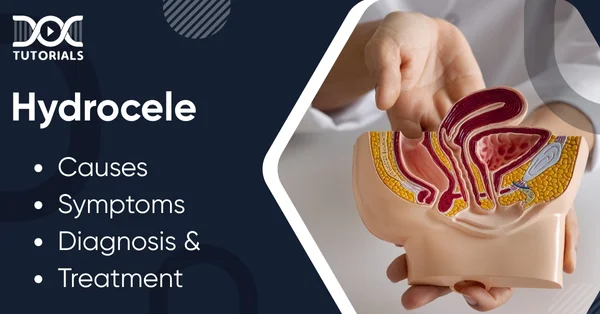Hydrocele: Causes, Symptoms, Diagnosis, and Treatment

Hydrocele is a condition that affects both infants and adult males, with varying prevalence in different age groups and geographies. In infants, it has a global prevalence of around 1 per 1,000 live births, increasing to 3.4 per 1,000 in children aged 7-12 years. It is uncommon but clinically significant in adult males, with a prevalence of approximately 1%.
Notably, in areas with endemic lymphatic filariasis, such as some parts of Africa and Southeast Asia, the prevalence of hydrocele could be much higher, affecting as many as 25% of men with the disease. Thus, understanding hydrocele disease, along with its types, risk factors, diagnosis, and other crucial aspects, is essential for timely diagnosis and avoiding complications.
Read on for more details.
What is a Hydrocele?
A hydrocele is a medical condition that causes the scrotum to swell due to fluid accumulating around the testicles. It is essentially pain-free and can be of several types:
There are two main kinds:
- Communicating Hydrocele: This condition is most common in infants. In this case, the tissue separating the stomach lining and scrotum has not closed, allowing fluid to flow in and out of the scrotum.
- Non-Communicating Hydrocele: This form of hydrocele is more common in adults and results when fluid remains entrapped due to inflammation or injury.
Hydroceles are usually harmless. However, anything with persistent swelling or accompanying symptoms such as pain or infection must be evaluated.
Based on the cause, hydrocele can be subdivided into the following categories:
- Primary Hydrocele: Develops without any visible cause.
- Secondary Hydrocele: Results from one of the following: infection, trauma, or tumour.
- Congenital Hydrocele: Present at birth and is usually self-limited.
- Acquired Hydrocele: Presents later in life because of external factors.
Each of these types has different implications concerning diagnosis and management.
What are the Causes of Hydrocele?
Hydrocele, in adults, is caused by any number of factors, for example:
- Trauma or Injury: Scrotal injury causes inflammatory changes leading to fluid accumulation.
- Infectious Causes: Epididymitis or orchitis often leads to secondary hydrocele.
- Surgical Complications: Mostly after surgery in the groin and scrotal areas.
- Tumours: Hydroceles may arise from any benign or malignant testicle tumour.
Causes of Hydrocele in Infants
Here is an overview of the hydrocele causes in children:
- Hydrocele most often occurs in newborns because of the persistence of the processus vaginalis.
- During development, this structure provides a tunnel through which the testicles descend from the abdomen into the scrotum.
- Usually, this tunnel closes at birth; if it stays open (the condition of patent processus vaginalis), abdominal fluid can flow into the scrotum, resulting in a hydrocele.
- This form usually resolves without treatment in the first year of life.
What are the Risk Factors of Hydrocele?
Some people are more prone to developing hydrocele. Risks include:
- Male infants (due to developmental anomalies)
- Older age
- History of scrotal surgery
- Injury or trauma to the genital region
- Sexually transmitted infections (STIs)
- Previous inguinal hernia repair
Understanding these risk factors is important for clinical diagnosis and planning.
What are the Symptoms of Hydrocele?
The symptoms of Hydrocele range from subtle to noticeable when the condition gets severe. Some common examples of symptoms include:
- Visible swelling of the scrotum. The swelling may increase during the day.
- A feeling of heaviness within the scrotum.
- Mild discomfort or pain may become significant if the hydrocele is large.
- Feeling of tightness or fullness.
Hydroceles are usually free from pain; however, it is worth seeing the doctor if there is any accompanying pain or sudden increase in size, as this may indicate complications. These complications might be an infection or testicular torsion.
How is Hydrocele Diagnosed?
To diagnose hydrocele scrotum, healthcare providers may perform the following:
- Physical Exam: A doctor may palpate the scrotum; tenderness, firmness, and size will be determined.
- Transillumination Test: Light passes through the scrotum, and in the case of a hydrocele, light passes through the fluid, causing the scrotum to glow.
- Ultrasound: Helps differentiate hydrocele from other causes of scrotal swelling, like hernias, tumours, or varicocele.
- Medical tests: Urinalysis and blood tests can determine the organism responsible for the infection.
Correct diagnosis makes way for proper treatment and excludes much more sinister conditions.
How is Hydrocele Treated?
Hydrocele disease is treated using the following methods:
- Observation in Infants
In cases that do not cause discomfort or other complications, hydrocele spontaneously resolves without therapeutic intervention within the first 12 to 24 months of life.
- Hydrocelectomy Surgery
Generally, if the infant hydrocele has not disappeared after 12 to 18 months, or if symptoms emanate from it in adults, surgery may be performed. Hydrocelectomy comprises:
- Sac of the hydrocele being removed or repaired
- This may occur under local or general anaesthesia
- It is a day procedure and often entails a low recovery time
It uses an effective approach to prevent future recurrences and offers patients long-term relief benefits.
- Aspiration
In some cases, particularly in resistant cases where surgery is not possible, aspiration can also be performed, which means draining the hydrocele fluid with a needle. However, aspiration has a high recurrence rate and may result in infection or fibrosis.
- Medication
There is no direct medicine for hydrocele in adults. However, if caused by infection, treatment involves:
- Antibiotics: For bacterial infections
- Analgesics and Anti-inflammatory Medications: To manage pain and swelling
Supportive care, such as scrotal elevation and snug underwear, may help reduce discomfort.
What are the Complications Associated with Hydrocele?
Hydrocele is generally benign but has some possible complications, which are:
- Infection: Increased risk with aspiration or an untreated secondary hydrocele.
- Hernia: A communicating hydrocele may be associated with an inguinal hernia.
- Testicular Atrophy: Rare in chronic, untreated cases, but possible.
- Infertility: Not an issue in most cases unless hydrocele is a co-diagnosis with other reproductive problems.
Timely diagnosis and management would reduce the chances of complications.
What are the Prevention and Lifestyle Modification Tips for Hydrocele?
Not all hydroceles are preventable, but some measures can be taken to lessen the risk:
- Keep the genital area clean
- Get prompt treatment for infections
- Practising safe sex to prevent STIs
- Periodic check-ups with doctors for early detection
FAQs About Hydrocele
- What is hydrocele disease?
Hydrocele disease is a medical condition characterised by the buildup of serous fluid in the scrotal sac around the testes, which leads to swelling.
- What causes hydrocele in adults?
Infections, trauma, tumours, or surgical complications are the most common causes.
- Can a hydrocele scrotum affect sexual life?
While hydrocele itself doesn’t directly affect sexual function, the associated discomfort or embarrassment may impact sexual activity.
- Is there any effective medicine for hydrocele in adults?
There is no specific medicine for hydrocele. However, if it is caused by an underlying infection, doctors can prescribe antibiotics.
- When should I see a doctor for hydrocele symptoms?
If you notice swelling, discomfort, or changes in the scrotum, seek medical evaluation to ensure timely diagnosis and management.
Conclusion
Lifestyle adjustments and prompt medical attention to all changes in the scrotum will help prevent and manage the condition. Hydroceles are typically benign factors that, at times, may give way to deeper problems like infections or trauma. Physical examination and imaging can quickly diagnose this condition for early management and better outcomes.
Understanding hydrocele in depth in terms of types, presentations, and management would benefit NEET PG aspirants and medical students. DocTutorials makes such high-yield topics easily accessible through expert video lectures, highly focused notes, and revision aids. Boost your learning and NEET PG exam preparation today with these exclusive study aids!
Latest Blogs
-

NEET PG Exam 2025- Date, Pattern, Marking Scheme, Subject Wise Weightage, and Exam Mode
NEET PG Exam 2025 is the ultimate gateway for medical graduates aspiring to pursue postgraduate courses in medicine, including MD,…
-

INI CET Exam 2025: Your Roadmap to Success – Key Topics, Strategies, and Lessons from Last Year’s Papers
The INI CET exam is more than just a test; it’s a significant milestone for many medical students aiming to…
-

INI CET Exam Success: Previous Year Question Papers & Ultimate Guide – INI CET PYQ
One can feel overwhelmed while preparing for the INI CET (Institute of National Importance Combined Entrance Test). A vast syllabus,…




